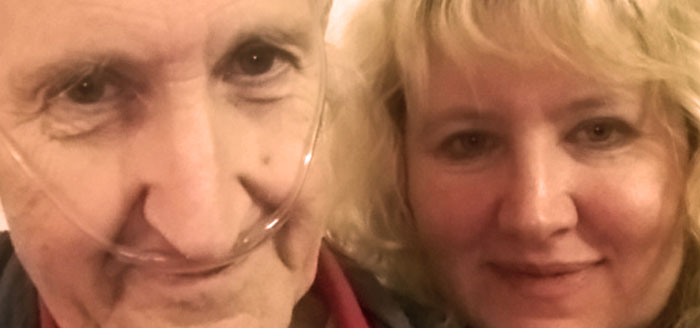Tracy Meek Remembers Her Father’s Battle with Pleural Mesothelioma

The United Kingdom is among the dozens of countries that have fully banned asbestos. Though the nation enacted the ban in 1999, mesothelioma and the continued dangers of asbestos persist. Countless workers have been exposed to asbestos on the job for many decades before the ban, and can still come into contact with the toxin in old buildings or schools that have old uses of the minerals in their walls.
Tracy Meek and her family hadn’t even heard of mesothelioma until her father Gordon became ill and his health deteriorated quickly. Gordon worked with engineering companies his whole working life, and the family recalls him likely being exposed to asbestos on the job.
The Dangers of Asbestos Insulation
For many decades, asbestos was heavily utilized for thousands of products, especially construction products like tiling, roofing and insulation. Installing and working with asbestos products put many workers at risk of exposure, as any damage or disturbance to the materials could release asbestos fibers into the air. Even today, workers or occupants of older buildings and homes that were built with asbestos materials face the risk of exposure.
Tracy recalled two companies in particular where her dad may have been exposed during his career. “He told us of how they were lagging the pipes with blue asbestos (a type of spray) whilst he was working there,” she explained.
Spray-on insulation like this became very popular, and these products could legally contain high amounts of asbestos, as it was a go-to flame retardant. Asbestos companies like W.R. Grace and Co. that made these types of products could contain as much 50% asbestos fiber in the insulation, putting countless workers at risk of inhaling the dangerous fibers. In the United States, even new types of insulation may still contain up to 1% of asbestos today, though many products utilize other flame retardants instead.
Though Gordon wasn’t applying the asbestos insulation directly himself, simply working in the building was enough to lead to exposure. In August, the first signs of his mesothelioma began to show as he experienced chest pain and went into the hospital.
“They found that he had fluid in the pleural cavity of his lungs,” Tracy said. “He had the fluid drained and then came home. He was admitted several times over the following weeks and again had his lung drained.”
It wasn’t until October that the family learned Gordon had cancer, though it would take a lot more testing to determine the type.
A Long Wait for a Diagnosis
Tracy and her family, like so many others, lived through the difficulties of properly diagnosing mesothelioma. Because of the latency period after exposure and the nonspecific symptoms, it can take weeks or even months for the rare cancer to be detected. “We were told that he had a type of cancer, but he had to undergo a lot of further tests to ascertain the type,” Tracy recalled. “It seemed to take a long time to actually get the diagnosis.”
The family tried to stay brave while they waited for the news. Tracy remembers her father being in denial about the severity of his condition, talking about day trips and summer holidays for the coming year. But after about a month of waiting, the family learned Gordon’s official diagnosis in mid-November: pleural mesothelioma.
Though pleural mesothelioma is the most common type of this rare cancer, patients still face a rather poor prognosis. The cancer often isn’t properly diagnosed until it has already developed to a later stage, which can greatly limit the treatment options available.
“Dad was told that chemotherapy would not help this type of cancer and that he wasn’t well enough to cope with it,” Tracy told the MAA Center. “This cancer is extremely aggressive, his health deteriorated very quickly.”
After having his lung drained on another occasion, the medical team decided to put in a permanent drain. But as time went on, Gordon had an increasingly difficult time breathing, and could no longer tolerate having the fluid drained from his lung. “He was in the hospital for two weeks whilst we located a home for him to go into, as he needed to be on permanent oxygen and it was felt that he needed to be cared for,” Tracy continued. “He was becoming increasingly panicky as he was struggling to breathe.”
Sadly, given the severity of his mesothelioma and the limited treatment available, Gordon passed away about a month after receiving his diagnosis.
Awareness and Early Detection Are Key
Better awareness around the dangers of asbestos and the diseases it can cause, likes mesothelioma, are essential. Though research has progressed over the years with new diagnostic methods and promising treatment, the best way to improve mesothelioma survival is through early detection.
Tracy hopes other families can be better aware of asbestos and go to their doctor early with any symptoms. “I think it is extremely important to stop others having to suffer in the way my dad did,” Tracy urged. Being aware and proactive is vital as long as asbestos is still not banned in so many places in the world, like the United States, and its old uses remain.